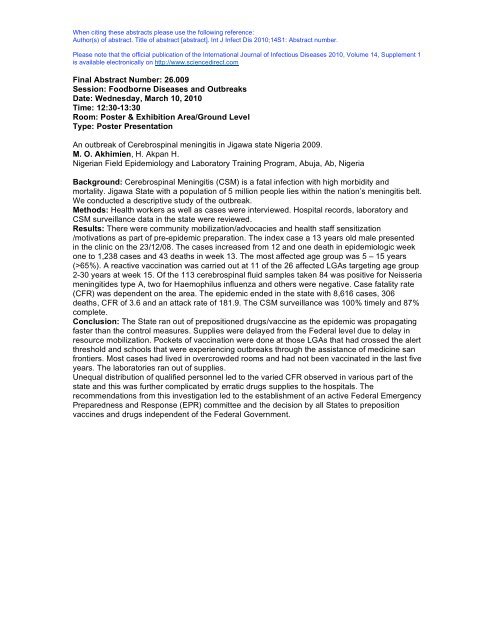14th ICID - Poster Abstracts - International Society for Infectious ...
14th ICID - Poster Abstracts - International Society for Infectious ...
14th ICID - Poster Abstracts - International Society for Infectious ...
You also want an ePaper? Increase the reach of your titles
YUMPU automatically turns print PDFs into web optimized ePapers that Google loves.
When citing these abstracts please use the following reference:<br />
Author(s) of abstract. Title of abstract [abstract]. Int J Infect Dis 2010;14S1: Abstract number.<br />
Please note that the official publication of the <strong>International</strong> Journal of <strong>Infectious</strong> Diseases 2010, Volume 14, Supplement 1<br />
is available electronically on http://www.sciencedirect.com<br />
Final Abstract Number: 26.009<br />
Session: Foodborne Diseases and Outbreaks<br />
Date: Wednesday, March 10, 2010<br />
Time: 12:30-13:30<br />
Room: <strong>Poster</strong> & Exhibition Area/Ground Level<br />
Type: <strong>Poster</strong> Presentation<br />
An outbreak of Cerebrospinal meningitis in Jigawa state Nigeria 2009.<br />
M. O. Akhimien, H. Akpan H.<br />
Nigerian Field Epidemiology and Laboratory Training Program, Abuja, Ab, Nigeria<br />
Background: Cerebrospinal Meningitis (CSM) is a fatal infection with high morbidity and<br />
mortality. Jigawa State with a population of 5 million people lies within the nation’s meningitis belt.<br />
We conducted a descriptive study of the outbreak.<br />
Methods: Health workers as well as cases were interviewed. Hospital records, laboratory and<br />
CSM surveillance data in the state were reviewed.<br />
Results: There were community mobilization/advocacies and health staff sensitization<br />
/motivations as part of pre-epidemic preparation. The index case a 13 years old male presented<br />
in the clinic on the 23/12/08. The cases increased from 12 and one death in epidemiologic week<br />
one to 1,238 cases and 43 deaths in week 13. The most affected age group was 5 – 15 years<br />
(>65%). A reactive vaccination was carried out at 11 of the 26 affected LGAs targeting age group<br />
2-30 years at week 15. Of the 113 cerebrospinal fluid samples taken 84 was positive <strong>for</strong> Neisseria<br />
meningitides type A, two <strong>for</strong> Haemophilus influenza and others were negative. Case fatality rate<br />
(CFR) was dependent on the area. The epidemic ended in the state with 8,616 cases, 306<br />
deaths, CFR of 3.6 and an attack rate of 181.9. The CSM surveillance was 100% timely and 87%<br />
complete.<br />
Conclusion: The State ran out of prepositioned drugs/vaccine as the epidemic was propagating<br />
faster than the control measures. Supplies were delayed from the Federal level due to delay in<br />
resource mobilization. Pockets of vaccination were done at those LGAs that had crossed the alert<br />
threshold and schools that were experiencing outbreaks through the assistance of medicine san<br />
frontiers. Most cases had lived in overcrowded rooms and had not been vaccinated in the last five<br />
years. The laboratories ran out of supplies.<br />
Unequal distribution of qualified personnel led to the varied CFR observed in various part of the<br />
state and this was further complicated by erratic drugs supplies to the hospitals. The<br />
recommendations from this investigation led to the establishment of an active Federal Emergency<br />
Preparedness and Response (EPR) committee and the decision by all States to preposition<br />
vaccines and drugs independent of the Federal Government.
















